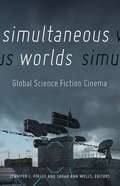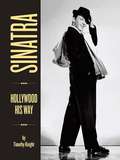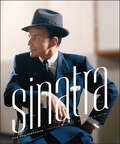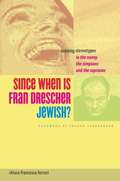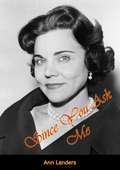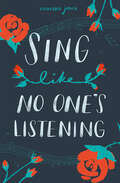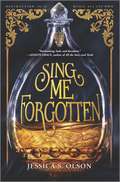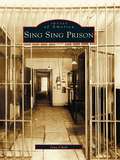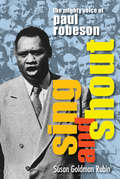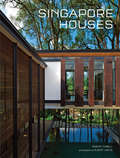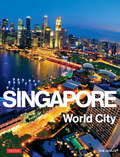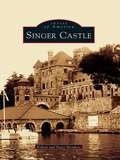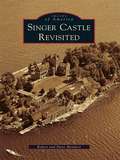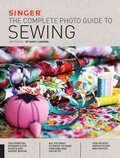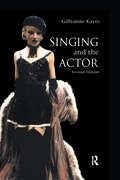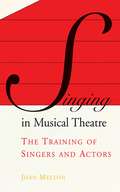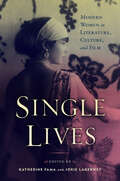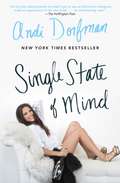- Table View
- List View
Simultaneous Worlds: Global Science Fiction Cinema
by Jennifer L. Feeley Sarah Ann WellsSince the 1927 release of Fritz Lang&’s pioneer film Metropolis, science fiction cinema has largely been regarded a Western genre. In Simultaneous Worlds, Jennifer L. Feeley and Sarah Ann Wells showcase authors who challenge this notion by focusing on cinemas and cultures, from Cuba to North Korea, not traditionally associated with science fiction. This collection introduces films about a metal-eating monster who helps peasants overthrow an exploitative court, an inflatable sex doll who comes to life, a desert planet where matchsticks are more valuable than money, and more.Simultaneous Worlds is the first volume to bring a transnational, interdisciplinary lens to science fiction cinema. Encountering some of the best emerging and established voices in the field, readers will become immersed in discussions of well-known works such as the Ghost in the Shell franchise and Neill Blomkamp&’s District 9 alongside lesser-known but equally fascinating works by African, Asian, European, and South American filmmakers. Divided into five parts that cover theoretical concerns such as new media economies, translation, the Global South, cyborgs, and socialist and postsocialist cinema, these essays trace cinema&’s role in imagining global communities and power struggles.Considering both individual films and the broader networks of production, distribution, and exhibition, Simultaneous Worlds illustrates how film industries across the globe take part in visualizing the perils of globalization and technological modernity. Ultimately, this book opens new ways of thinking about world cinema and our understanding of the world at large.
Sinatra: Hollywood His Way
by Timothy KnightIn the scores of posthumous tributes paid to Frank Sinatra after his death in 1998, most focused on his extraordinary reign as ?The VoiceOCO of twentieth-century pop music. But Sinatra was much more than a music icon. He was also one of the most popular movie stars of the 1940s, OCO50s, and OCO60s?an Academy-Award winning actor with some sixty film credits to his name. He starred in some of the most iconic films of the twentieth century and with some of the biggest names of the day. There were his dancing days with Gene Kelly in "Anchors Aweigh" and "On the Town"; his acclaimed dramatic turns in "From Here to Eternity" and "The Manchurian Candidate"; and his signature Rat Pack movies such as "OceanOCOs Eleven. ""Sinatra: Hollywood His Way" is a complete, film by film exploration of this true Hollywood legend. His screen history is vividly brought to life through illuminating reviews, behind-the-scenes stories, and hundreds of rare color and black-and-white photographs, making this the ultimate guide to the films of Frank Sinatra and an essential in the library of any fan. "
Sinatra: The Photographs
by Andrew HowickFull of commentary by the people who knew him best, this exceptional collection of photographs showcases Frank Sinatra like never before. Nobody packed a visual punch like Frank Sinatra. With his clothes, his gestures, his posture, and even his facial expressions, Sinatra exuded a confident swagger that inspired generations. Photographs capture not only his ineffable sense of style, but also his aura of vulnerability, intensity, sexuality, and charm. Sinatra: The Photographs focuses on the decades after World War II, when he towered over the American entertainment landscape. These were the years of the Rat Pack and Las Vegas, socializing with Jack Kennedy and Marilyn Monroe, and making music with Nelson Riddle, Count Basie, and Quincy Jones. Featured here is the best work by a group of photographers—Ted Allan, Bob Willoughby, Ed Thrasher, Sid Avery, and Bernie Abramson—who helped shape the public image of an immortal legend. &“Andrew Howick, who helps curate and edit one of the world&’s largest collections of photos of Sinatra, collects a stunning array of photographs that helped shape the singer&’s persona.&” —Publishers Weekly
Since When Is Fran Drescher Jewish?: Dubbing Stereotypes in The Nanny, The Simpsons, and The Sopranos
by Ferrari Chiara Francesca"Since when is Fran Drescher Jewish?" This was Chiara Francesca Ferrari's reaction when she learned that Drescher's character on the television sitcom The Nanny was meant to be a portrayal of a stereotypical Jewish-American princess. Ferrari had only seen the Italian version of the show, in which the protagonist was dubbed into an exotic, eccentric Italian-American nanny. Since When Is Fran Drescher Jewish? explores this "ventriloquism" as not only a textual and cultural transfer between languages but also as an industrial practice that helps the media industry foster identification among varying audiences around the globe. At the heart of this study is an in-depth exploration of three shows that moved from global to local, mapping stereotypes from both sides of the Atlantic in the process. Presented in Italy, for example, Groundskeeper Willie from The Simpsons is no longer a belligerent, alcoholic Scotsman but instead easily becomes a primitive figure from Sardinia. Ironically, The Sopranos - a show built around Italian-Americans - was carefully re-positioned by Italian TV executives, who erased the word "mafia" and all regional references to Sicily. The result of Ferrari's three case studies is evidence that "otherness" transcends translation, as the stereotypes produced by the American entertainment industry are simply replaced by other stereotypes in foreign markets. As American television studios continue to attempt to increase earnings by licensing their shows abroad, Since When Is Fran Drescher Jewish? illuminates the significant issues of identity raised by this ever-growing marketplace, along with the intriguing messages that lie in the larger realm of audiovisual cultural exchange.
Since You Ask Me
by Ann LandersSensible, Entertaining Answers To Everyone’s Problems—Including YoursA fresh new look at:• The common-sense approach to marriage• Getting older• The importance of sex in marriage• The battle of the bottle• Teenagers and sex• And much more...Ann Landers’ warmth, wit and realistic wisdom have made her America’s most widely read human relations columnist—syndicated in more than 550 newspapers! Now, in this witty and thought-provoking book, she offers the sum and substance of her long experience with life’s oldest bugaboo—trouble! It deserves a place on everyone’s bookshelf.“This book is about trouble—that uninvited guest who visits us all. Trouble is the common denominator of living. It is the great equalizer.“Trouble is no respecter of age, financial standing, social position or academic status. Trouble comes to people in high and low places alike. It is not a sign of stupidity, weakness, or bad luck. It is evidence that we are card-carrying members of the human race. As someone once put it, “Only the living have problems.”“This book is about how to prevent trouble and what to do about it when you can’t prevent it.”—Ann Landers
Sing Like No One's Listening
by Vanessa JonesNettie Delany has just been accepted into a cutthroat performing arts school, but she hasn't been able to sing a single note since her mother died.Duke's Academy of Performing Arts isn't for the weak-willed or easily intimidated; the school has mentored plenty of big names, including Nettie's own mother—a ballerina superstar. With the shadow of grief haunting her every step, Nettie has her work cut out for her if she plans to stay enrolled in a highly coveted program.No room for error. Nettie must work through the pain of the past, horrible classmates, and vicious teachers to find her voice again and deliver a showstopper. If not, she faces expulsion. With the help of her friends and a new romance, can Nettie get it together in time? Everyone is watching.Former West End performer and author Vanessa Jones delivers a well-crafted journey of grief and healing in this contemporary young adult novel. An ideal read for fans of theater and Broadway musicals.
Sing Me Forgotten
by Jessica S. OlsonIsda does not exist. At least not beyond the opulent walls of the opera house.Cast into a well at birth for being one of the magical few who can manipulate memories when people sing, she was saved by Cyril, the opera house’s owner. Since that day, he has given her sanctuary from the murderous world outside. All he asks in return is that she use her power to keep ticket sales high—and that she stay out of sight. For if anyone discovers she survived, Isda and Cyril would pay with their lives.But Isda breaks Cyril’s cardinal rule when she meets Emeric Rodin, a charming boy who throws her quiet, solitary life out of balance. His voice is unlike any she’s ever heard, but the real shock comes when she finds in his memories hints of a way to finally break free of her gilded prison.Haunted by this possibility, Isda spends more and more time with Emeric, searching for answers in his music and his past. But the price of freedom is steeper than Isda could ever know. For even as she struggles with her growing feelings for Emeric, she learns that in order to take charge of her own destiny, she must become the monster the world tried to drown in the first place.
Sing Sing Prison (Images of America)
by Guy CheliA popular backdrop for numerous movies, Sing Sing, or "the Big House," has been a site of both controversy and reform. The history of Sing Sing dates back to 1825, when warden Elam Lynds brought one hundred inmates to begin construction of the prison "up the river" on the banks of the Hudson. The marble quarry that supplied the building material for the prison was located in an area that was once home to the Sint Sink, a Native American tribe whose name means "stone upon stone." Prison life was dominated by hard labor during the early years. Convicts in striped suits and shackles built the prison with their own hands. With the arrival of warden Lewis Lawes in 1920, Sing Sing became the most progressive prison of its kind. During this time, the New York Yankees traveled up to Sing Sing to play the prison's home baseball team; the prison grounds were landscaped with shrubbery and flower gardens; and the compound grew to include a chapel, mess hall, barbershop, library, and gymnasium. The electric chair was first introduced at Sing Sing in 1891. Julius and Ethel Rosenberg, the first civilians to be found guilty of espionage, were put to death there in 1953. Sing Sing Prison contains rare photographs from the prison archives, the Ossining Historical Society, and a private collection.
Sing and Shout: The Mighty Voice Of Paul Robeson
by Susan Rubin GoldmanThis comprehensive biography, written by celebrated nonfiction author Susan Goldman Rubin, explores the tumultuous and passionate life of activist, singer, and actor Paul Robeson.When faced with the decision to remain silent or be ostracized, Paul Robeson chose to sing, shout, and speak out. Sing and Shout: The Mighty Voice of Paul Robeson explores how Robeson's love of African American spirituals and deep empathy towards the suffering of others drove his long, fervent mission as a civil rights activist and his career as an artist. Although he was also an actor, singing was Robeson's defining talent and where he could best express himself. After exploring socialism, Robeson was targeted by the U.S. government for speaking out about discrimination against African Americans and for his political views. He was labeled a communist during the height of the Cold War and found himself stripped of his U.S. passport. But Robeson never gave in and continued to perform and speak out. The book is based on Rubin's extensive research, including fieldwork in Harlem, NY, in Princeton and Somerville, NJ, and at Rutgers University in New Brunswick, NJ. Includes an author's note, resources, source notes, index, and a preface by author Harry Belafonte.
Sing for Your Supper: The Broadway Musical in the 1930s
by Ethan Mordden“[Mordden] excels at delineating the contrasting styles and personalities [of] Broadway’s busiest—and in showbiz terms, best—songsmiths of the 1930s.” ―Richmond Times-DispatchIn the 1930s, Broadway's lights still burned brightly. Ethan Mordden completes his history of the Broadway musical by taking a look at this forgotten era. Shows like Anything Goes brought the glitter of Cole Porter and Merman's brass to the public. Innovations in dance were pioneered by Balanchine and others. Scenic advancements made Astaire's The Band Wagon move across the stage in novel ways. Gershwin's revolutionary Porgy and Bess entered the canon of American Classics. And The Cradle Will Rock and Johnny Johnson took the American political temperature. With his trademark wit and style, Ethan Mordden shines the spotlight on Broadway's forgotten decade.“Mordden is an encyclopedia of knowledge about the Broadway musical. Fortunately, his information is so well organized and his conversational writing style so smooth that this tome never feels like a mere onslaught of facts. Those who are devoted to musical theater will love this comprehensive historical look.” —Publishers Weekly“Ever the enthusiastic aficionado, Mordden ferrets out the fascinating moments and important details of this period . . . invaluable.” ―Booklist
Singapore Houses
by Robert Powell Albert Lim KsDemonstrating a remarkable surge of design exploration in the city-state, Singapore Houses charts the architects of Singapore whom are producing work with a level of refinement and sophistication that is comparable with the best in the world. The houses include recent designs by doyens of the profession such as Sonny Chan Sau Yan, Kerry Hill and Ernesto Bedmar in addition to the firmly established "next" generation including Mok Wei Wei, Chan Soo Khian, Siew Man Kok and Richard Hassell.
Singapore Houses
by Robert Powell Albert Lim KsDemonstrating a remarkable surge of design exploration in the city-state, Singapore Houses charts the architects of Singapore whom are producing work with a level of refinement and sophistication that is comparable with the best in the world. The houses include recent designs by doyens of the profession such as Sonny Chan Sau Yan, Kerry Hill and Ernesto Bedmar in addition to the firmly established "next" generation including Mok Wei Wei, Chan Soo Khian, Siew Man Kok and Richard Hassell.
Singapore World City
by Kim InglisIn just a few short decades, Singapore has transformed itself from a tiny island off the coast of mainland Asia into a global superpower in banking, IT, education, biotech, transportation and many other fields. The fascinating story of how this tiny city-state which has no hinterland, no natural resources, and a relatively small population has achieved success is told in this book. Singapore's history as a British colonial port, its dynamic multi-ethnic population, and its innovative governmental and social structures, are a part of the story. But there are others as well. How Singapore became a regional hub for finance, shipping and air travel, and now also for the arts, sport and leisure-are all showcased in dynamic detail, with over 300 full-color photographs to illustrate graphically how this small island functions like a well-tuned racing machine. From the world's only night-time Formula One race to its thriving calendar of international and local events, and its culture of non-stop eating, drinking and clubbing, Singapore has finally stepped out of the shadows and onto the world stage. Famed for its innovative business prowess, what is less known is that the island has more parks, gardens and recreational facilities than any other city of comparable size. Author Kim Inglis, a journalist and long-time local resident, leads the reader on a series of explorations through Singapore's most notable districts and neighborhoods, explaining the growth and importance, and showcasing what they have to offer the visitor. Included are many lesser-known corners of the island which very few visitors ever get to see!
Singapore: World City
by Kim InglisIn just a few short decades, Singapore has transformed itself from a tiny island off the coast of mainland Asia into a global superpower in banking, IT, education, biotech, transportation and many other fields. The fascinating story of how this tiny city-state which has no hinterland, no natural resources, and a relatively small population has achieved success is told in this book.Singapore's history as a British colonial port, its dynamic multi-ethnic population, and its innovative governmental and social structures, are a part of the story. But there are others as well. How Singapore became a regional hub for finance, shipping and air travel, and now also for the arts, sport and leisure-are all showcased in dynamic detail, with over 300 full-color photographs to illustrate graphically how this small island functions like a well-tuned racing machine.From the world's only night-time Formula One race to its thriving calendar of international and local events, and its culture of non-stop eating, drinking and clubbing, Singapore has finally stepped out of the shadows and onto the world stage. Famed for its innovative business prowess, what is less known is that the island has more parks, gardens and recreational facilities.
Singapore: World City
by Kim InglisIn just a few short decades, Singapore has transformed itself from a tiny island off the coast of mainland Asia into a global superpower in banking, IT, education, biotech, transportation and many other fields. The fascinating story of how this tiny city-state which has no hinterland, no natural resources, and a relatively small population has achieved success is told in this book.Singapore's history as a British colonial port, its dynamic multi-ethnic population, and its innovative governmental and social structures, are a part of the story. But there are others as well. How Singapore became a regional hub for finance, shipping and air travel, and now also for the arts, sport and leisure-are all showcased in dynamic detail, with over 300 full-color photographs to illustrate graphically how this small island functions like a well-tuned racing machine.From the world's only night-time Formula One race to its thriving calendar of international and local events, and its culture of non-stop eating, drinking and clubbing, Singapore has finally stepped out of the shadows and onto the world stage. Famed for its innovative business prowess, what is less known is that the island has more parks, gardens and recreational facilities.
Singapore: World City
by Kim InglisIn just a few short decades, Singapore has transformed itself from a tiny island off the coast of mainland Asia into a global superpower in banking, IT, education, biotech, transportation and many other fields. The fascinating story of how this tiny city-state which has no hinterland, no natural resources, and a relatively small population has achieved success is told in this book.Singapore's history as a British colonial port, its dynamic multi-ethnic population, and its innovative governmental and social structures, are a part of the story. But there are others as well. How Singapore became a regional hub for finance, shipping and air travel, and now also for the arts, sport and leisure-are all showcased in dynamic detail, with over 300 full-color photographs to illustrate graphically how this small island functions like a well-tuned racing machine.From the world's only night-time Formula One race to its thriving calendar of international and local events, and its culture of non-stop eating, drinking and clubbing, Singapore has finally stepped out of the shadows and onto the world stage. Famed for its innovative business prowess, what is less known is that the island has more parks, gardens and recreational facilities.
Singer Castle
by Robert Mondore Patty MondoreIn 1905, the New York Times called it "the Castle of Mysteries," and rightly so. Located on Dark Island, Singer Castle was modeled after the castle described in Sir Walter Scott's Woodstock, complete with dungeons, turrets, labyrinths, and even secret passageways. World-famous architect Ernest Flagg designed it for Singer Sewing Machine Company president Frederick Bourne. Singer Castle provides an unforgettable tour and fascinating history, revealing why this place is truly a castle of mysteries.
Singer Castle Revisited (Images of America)
by Robert Mondore Patty MondoreSinger Castle Revisited is a fresh look at this castle's rich 100-year history with many new stories and photographs of its original owner, Frederick G. Bourne; his daughter Marjorie, who owned the castle for the next 40 years; and Dr. Harold and Eloise Martin. The Bournes were well known for their marvelous collection of yachts and Gold Cup-winning speedboats. Since the release of Singer Castle, the new owners of this historical Thousand Islands landmark have invested nearly $10 million into restoring it to its original condition. In addition, gracious relatives of the former owners' families have shared their private collections of previously unpublished pictures dating from as far back as the castle's construction.
Singer: The Complete Photo Guide to Sewing
by Nancy LangdonThe essential one-stop sewing machine reference with hundreds of photos and diagrams, covering everything from fundamentals to advanced techniques. Discover the mysteries of your sewing machine! Learn ways to get the most out of your machine and attachments, the best tools to use, and how to sew with a variety of fabrics. Then dive into sewing techniques for beautiful garments and stunning home décor designs: Learn how to make and finish seams; lay out, cut, and mark patterns; sew bias strips; and make pillows, cushions, and piping.Get tips and techniques for serger sewing, and discover how to create serger seams and finishes. Tackle first-time sewing projects with confidence, and refresh your memory on favorite techniques. Boost your wardrobe by altering store-bought patterns for a perfect custom fit. Refresh your tabletop with gorgeous tablecloths, placemats, and napkins, and create impressive bed and bath accessories.Ready to build your sewing skills and achieve professional results? You’ll learn how to:Operate your sewing machine or serger like a proCustomize clothing with buttons, pockets, collars, and moreMake buttonholes with easeCreate seam finishes, make closures, and attach zippersSew your own activewearMake slipcovers, pillowcases, and duvet covers, and morePacked with so much information, this valuable resource offers a lifetime of sewing success for all skill levels. Start your sewing journey today and see what amazing things you can create!
Singing With Your Own Voice
by Orlanda CookThis is a comprehensive, practical, encouraging book full of exercises and tips for anyone who wants to – even needs to – sing. Actors in straight plays, performers in musicals, professionals and amateurs, even people singing in choirs or bands will all benefit from Orlanda Cook's expert guidance.
Singing and the Actor (Ballet, Dance, Opera And Music Ser.)
by Gillyanne KayesSinging and the Actor takes the reader step by step through a practical training programme relevant to the modern singing actor and dancer. A variety of contemporary voice qualities including Belting and Twang are explained, with excercises for each topic.
Singing in Musical Theatre: The Training of Singers and Actors
by Joan Melton Angela Punch McgregorWhat does it take to be a musical theatre performer? What kind of training is required to do eight shows a weekacting, dancing, and singing in a wide variety of vocal styles? This insider's look into the unique demands of musical theatre performance establishes connecting links between voice training for the singer and drama school training for the actor. By reading these revealing interviews, performers in every area of theatre can: - Discover what it takes to go from a first lesson to a solid professional technique Consider the requirements for singers in musical theatre today, how they have changed, and where they are going - See how different teachers approach six aspects of voice training: alignment, breathing, range resonance, articulation, and connection Understand the interconnectedness of musical theatre and theatre voice. A foreword by leading Australian actor Angela Punch McGregor personalizes the connective links among trainings as she describes her preparation for Sunset Boulevard. A must-read for anyone who is serious about voice and the theatre.
Singing the Turtles to Sea: The Comcáac (Seri) Art and Science of Reptiles
by Gary Paul NabhanThe Comcaac Indians of NW Mexico (better known as the Seri) are a small indigenous group with a precise folk classifications, rich folklore, and interesting traditional uses for snakes lizards, and turtles in their area, including the rare leatherback turtle. This book attempts to preserve natural knowledge by preserving cultural knowledge.
Single Lives: Modern Women in Literature, Culture, and Film
by Kristin Celello Pamela Robertson Wojcik Benjamin Kahan Emma Liggins Ann Mattis Jorie Lagerwey Katherine Fama Andreá N. Williams Jennifer S. Clark Elizabeth DeWolfe Martina Mastandrea Ursula KaniaSingle Lives is a collection of singleness studies essays from the interdisciplinary humanities that explores the last two hundred years of literature and popular media by, about, and for single women in the US and the UK. Independent women have always been a center around which social anxieties and excitement coalesced. Moving between the family home and domestic independence, between household and public labor, and between celibacy and a range of sexual relations, the single woman remains a literary and cultural focus, as she has been from the 19th to the 21st centuries. This collection offers readers the opportunity to uncover the social, political, economic, and cultural connections between the "singly blessed" women and "bachelor girls" of the 19th and early 20th century and "all the single ladies" of the 21st century. Essays read singleness across genre and field, offering new approaches to studying modern and contemporary single women in literature, film, and history. Authors engage scholarship from wide ranging fields of social history, women's studies, queer theory, and Black feminism. The collection reads familiar texts against the grain, rethinking archival resources, revisiting familiar figures, and exploring new sources: cookbooks, ephemera, personal documents, recovered film histories, and forms of domestic space and labor.This is a book for scholars of gender and sexuality, social history, feminist film and media scholars, and literary historians, and reflects the urgent contemporary interest in single women as a political, economic, and cultural force.
Single State of Mind
by Andi Dorfman<P>Andi Dorfman, breakout star of ABC’s The Bachelorette and New York Times bestselling author of It’s Not Okay, returns with this new collection of her adventures as a still-single gal surviving and thriving in New York City.Sharing moments like finding her first New York apartment (the front door broke so she had to use the fire escape), her first dates on “celebrity Tinder” and finally, watching her ex-fiancé propose to another woman on Bachelor in Paradise, Andi Dorfman doesn’t shy away from pulling back the curtain on the life of a reality star who’s returned to reality. <P>Dorfman’s supremely relatable personality has inspired incredible devotion from her fans, who follow her every move on social media. Filled with a mix of romantic mishaps, city adventures, and, of course, plenty of insider Bachelor details, Andi’s new book is Sex and the City for the reality TV generation. <P><b>A New York Times Bestseller</b>
